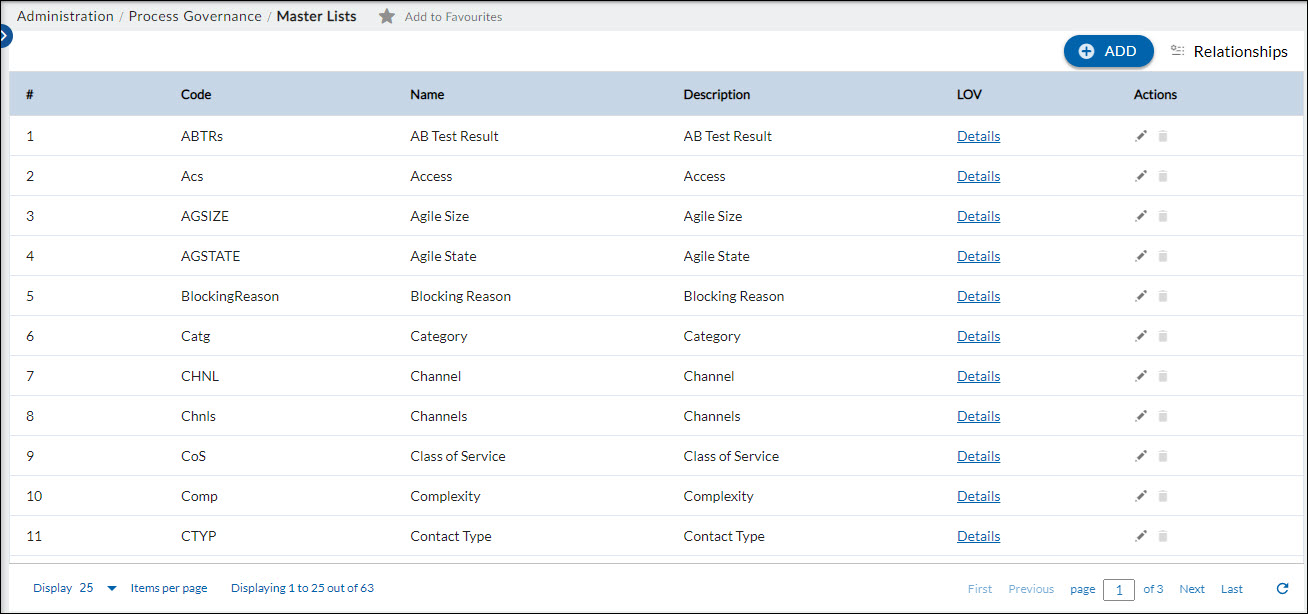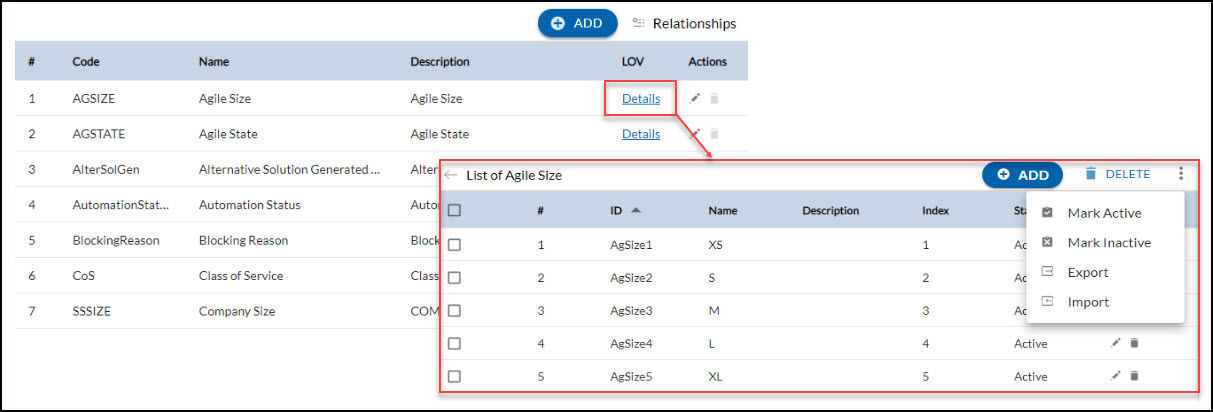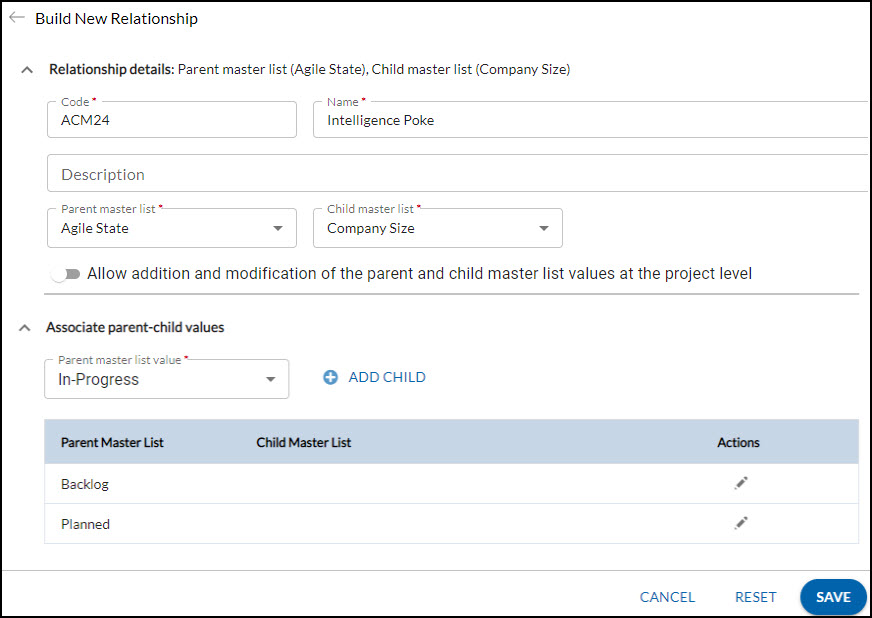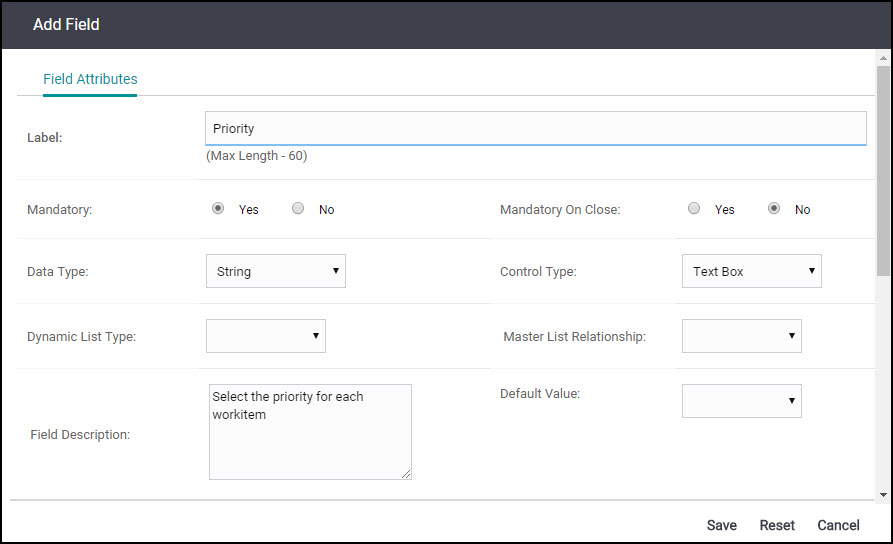In this article, we will help you to understand how to define master lists in process governance.
|
Skip Ahead to: |
Overview
In the application, various master lists are available. The application allows maintaining these Master Lists that are activated in the organization and within projects i.e. you can add, change, or remove any values from the Master lists.
The Master Lists feature enables you to:
- Define Master Lists
- Define Master List Relationships
- Associate Form Fields using Master Lists Relationship
Navigation
In the left navigation panel, expand the Apps menu and select Organization name. Hover over the Process Governance breadcrumb at the top, expand the Process Governance module, and select Master Lists.
Define Master Lists
Prerequisite: The Master Lists module should be available to add and edit Master Lists in the Administration.
- Click the ADD button.
- Enter the relevant attributes of the creation of a Master List:
-
- Code: Enter a code to identify the Master List throughout the application
- Name: Enter an appropriate title for the Master List. You can enter the master list name of up to 1800 characters.
- Description: Provide a brief description of the Master List.
- Sort By:
Index-wise- Master Lists values are to be displayed in the ascending order of the Index code on adding the values to the Master Lists.
Alphabetically-Master Lists values should be displayed alphabetically in ascending order when the user has to select the field of an item.
-
- Select “Allow addition of values at the project level” to allow adding values to master lists in projects and templates.
- Click the SAVE button.
To modify a Master List, click the Edit icon under the Actions column of the required Master Lists. After the Master Lists are added, you can only modify the Sort By at the level where the Master Lists were created i.e. Process Governance or Project.
Once the Master Lists are added, they will be listed in the Master Lists view.
Managing Master List Values
Adding Values to the Master List
- Navigate to the Detail link of the desired Master List to manage its values.
- Add a Value:
- Use the Add option to include new values.
- Enter the value Name, optional Description, and toggle the Active status if required.
- Select an Icon to represent the value. Icons help visually identify each value for better clarity and usability.
Following are the categories you can choose icons from:- Alphabets
- Arithmetic Operation
- Charts
- Cloud Storage
- Coding
- Colored
- Coordinate System
- Country Flag
- Currency Colored Icon
- Currency Material Icon
- Greek Letters
- Health Indicators
- Material Icons
- Measurement
- Priority
- Sizes
- Software development
- Softwares

Modifying Master List Values
- Click the Edit icon under the Actions column for the value you want to modify.
- Update the Name, Description, or Sort by as needed.
Active/Inactive: Use the Active toggle to mark values as active or inactive.
You can also export/import values from XLS, XLSM or CSV files or export the existing list for bulk updates.
Icon Usage Across the Application
Currently, icons added to Master List values are displayed in the following areas for enhanced visibility:
Project Level
- Execution Board: Provides quick visual cues for the cards on the Board.
- Workitem Listing: Helps in identifying workitems more efficiently.
- Workitem Details Section: Displays icons alongside text in dropdown fields for better contextual understanding.
- Backlog Refinement – Provides quick visual cues for the cards on all the sections Backlog, Groomed Backlog and Sprint Planning
- Dashboard – Displays icons alongside text in dropdown fields in the chart setting for better contextual understanding.
Organizational Level
Project Listing: Provides quick visual cues for the Projects
User Listing: Provides quick visual cues for the Users in the Organization
Dashboard: Displays icons alongside text in dropdown fields in the chart setting for better contextual understanding.
Values configured at the organization level will flow along with their associated icons to the project level.
Notes:
- Values configured at the organization level will flow along with their associated icons to the project level.
- Some default Master Lists, such as SLA Type and SLA Goal Unit, cannot be modified, exported, or imported.
- Sort By can only be modified at the level where the Master List was created (e.g., Organization level in the Administration workspace).
Default Master Lists
Following are a few of the default Master Lists and their descriptions:
-
Project Type: Create project types to categorize projects and templates when creating them. For example, SAP implementation, maintenance projects, and so on.
-
Unit of Measurement (UOM): Create a Unit of Measurement to add effort estimates or user story estimates. For example, FP (Function Points) for Effort Estimation.
- Blocking Reason: Add a reason while blocking a card. By default, there are 5 reasons in the master list.
-
User Levels: Create broad groups for user access in the hierarchy. Different users in the application have access to different Workspaces, Modules Groups, Modules, and Features of the application depending on their role within the organization. Access levels determine what data users can view, create, and edit.
See Defining Master Lists Relationship to set relationship between two Master Lists, which enables to select values in one Form field, depending on the value selected in another field of a workitem. This also requires fields to be associated in the required Form of the workitem.
Following are some rules that are to be considered for Master Lists created in the organization’s hierarchical tree structure.
Consider the following scenario where the Root Organization is the parent organization. Assume that the child organizations of the parent organization are Sub-Organization1 and Sub-Organization2. In the above diagram, Root Organization and Sub-Organization1 are one hierarchical tree structure and Root Organization and Sub-Organization2 is another hierarchical tree structure.
The rules that apply to all the items in the Master Lists are mentioned below:
- You cannot have a duplicate master list item name in an organization’s hierarchical tree structure.
For example: Assume that in Sub-Organization1 there is a master list item named: Item1. And if you try to create a master lists item with the same name in the Root Organization, then there is an option in which, that particular item in the Sub-Organization1 is displayed only in the Root Organization. A confirmation message is displayed when you try to do so.
- You cannot have a duplicate master list item name across the hierarchical tree structure.
For example: Assume that in Sub-Organization1 there is a master list item named: Item1 and also in Sun-Organization2 there is a master list item named: Item1. In such a situation, you cannot create a master list item named: Item1 in the root organization.
- You cannot modify the master list item name if it is used in any form of an organization. When modifying a master lists item name, if you duplicate a name in the hierarchical tree structure, then there is an option, if selected, that particular item is replaced from the original place.
For example: Assume that in the Root Organization, there is a master list item named: Item 2, and in Sub-Organization1 there is a master list item named: Item1. If you try to modify the name of the master lists item named Item2 with Item1 then two things happen:
- Delete Item2 if it is not used in any Forms.
- An option for replacing Item1 from Sub-Organization1 to the Root Organization is displayed.
- You can only view the master list item names of a parent organization. You cannot modify or delete that particular master list item.
For example: Assume that in the Root Organization, there is a master lists item named: Item 2. Then when you switch context to Sub-Organization1 you can view Item2 but you cannot modify/delete Item2.
Defining Master Lists Relationships
You can configure Form fields defining relationships between them using the Master Lists. This enables Form fields in workitems to display a dynamic list based on the selection in one field.
For example, assume there are two Master Lists- Industry Type (consider as Parent Master List) and Functional Area (consider as Child Master List). You have defined a Master Lists Relationship between these two fields in the Change Request Form. When a Business Analyst creates a Change Request and selects Financial Services as Industry in the Industry Type list. Depending on the functional areas mapped in the Master Lists Relationship, the areas will be displayed in the Functional Area Lists, such as Banking, Insurance, and Loans.
Prerequisites
The Master Lists module should be available for adding and editing Master Lists Relationships in the Administration.
The Master Lists are created between which you want to define the relationship.
To create a Master Lists relationship:
- Click the Relationships icon on the Master Lists page.
- To add a master list relation, click the ADD button.
- Enter the relevant attributes pertaining to the build a New Relationship:
-
- Code: Enter a code to identify Master List throughout the application
- Name: Enter an appropriate title for the Master List Relation
- Description: Provide a brief description of the Master List
- Parent master list: Select the Parent master list
- Child master list: Select the Child master list.
-
- Select “Allow addition of values at the project level” to allow adding values to master lists in projects and templates.
- Next, to associate the values in the Child Master List to a value in the parent master list, select a value in the Parent master list value list. Click on the ADD CHILD button.
- Then, add all of the required values (using the CTRL/SHIFT key and selecting) from the Available Values list displayed in the Child Master List. Then, click on SAVE to associate the required Child Master list values with each Parent Master List value.
- Now, you can check the Parent Master List and Child Master List values. To add or edit values, click the Edit icon. If you are done entering values.
- Click the SAVE button.
To add or delete any values in the Parent or Child Master lists, go to Master List view and click the Detail link for the required Master List.
If Projects are allowed to add or remove Master List values (where Allow addition of values at the project level option is selected in Master List Relationship created in the organization), the additional Inherited Values pane displays the inherited values as you select the Parent Master List value. For your project, you can add an inherited value associated with one Parent Master List value to another Parent Master List value, for example, E-Learning Functional Area associated with Education Industry Type can also be associated with IT Outsourcing Industry Type. Check the association between Parent and Child Master Lists before saving. On saving the Master Lists Relationship, it is listed on the Master Lists Relationship page.
If projects are not allowed to edit the Master List relationship, it will be shown in the read-only view.
Associating Form Fields using Master Lists Relationship
After the Master Lists Relationship is defined, add a Form field (as the parent field which will control the child field, for example, Country) in the required Field Segment, for example, Details.
When adding the parent Form field, select Dynamic List in the Data Type list and the Drop-Down box in the Control Type list. In the Dynamic List Type, select the Parent Master List, which is included and set in the Master Lists Relationship. When adding the child Form field, select Dynamic List in the Data Type list, Drop-Down box in the Control Type list, and then select the Master Lists Relationship that you have set.
When you are looking for the Master Lists you defined, note that the custom master list has ‘List’ suffixed after the Master Lists Name, for example, Country List.
Now, for example, when you add a Change Requests, you will see the two Form fields, Industry Type and Functional Area. As you select an Industry in the Industry list, the Functional Area list will display the related areas.





